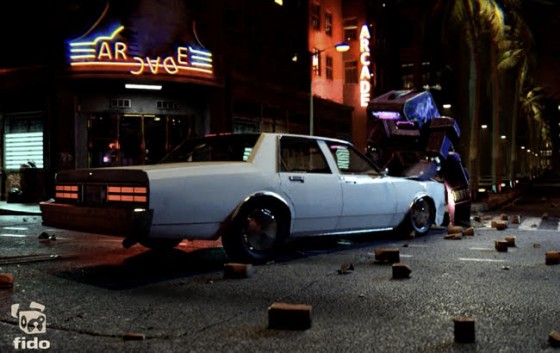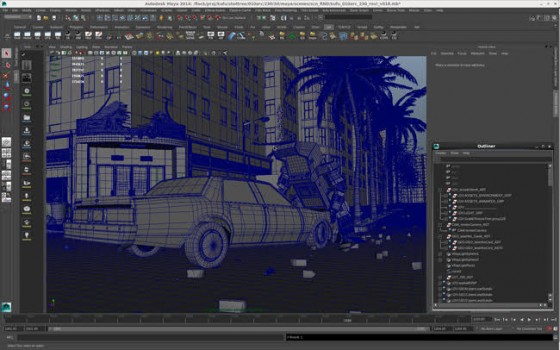David Sandberg scooped up $630,000 on Kickstarter and put together a hilarious short film in Autodesk Maya and 3ds Max.
Please forgive me, I’m laughing as I write about Kung Fury, a new online movie that premiered recently at Cannes. I’m not laughing at the artistry or the technology, which are both top notch, but because I’m playing Kung Fury on my second screen as I write. It is a funny hilarious send-up of 80s action movies; heavy on big hair, big attitudes, and ludicrous villains. There’s a link to the 31-minute movie at the bottom of this article.
Before-and-after views of one VFX shot,
recreating a crime scene on the streets of 1985 Miami.
(Source: Autodesk and LaserUnicorns)
But back to the technology. David Sandberg pitched Kung Fury to Kickstarter, where it netted $630K, giving Sandberg the means to really rock his vision of a CG-fueled action comedy. “There are so many fun, crazy characters, environments and scenarios in Kung Fury that VFX played a crucial role in the story,” says Sandberg. “Because of my background in commercial production, I’m familiar with all the VFX tools and techniques, so I worked closely with [Scandinavian VFX house] Fido on the VFX. With outstanding creative talent like Fido behind the wheel of software like Maya, almost anything is possible, and that’s evident in the VFX they delivered for Kung Fury.”
The story unfolds in three major environments: a street intersection, a police station interior and a huge steampunk-inspired Nazi hall. Fido created each environment digitally and then integrated the work with live action green screen footage of actors. Given trailer assets originally designed by Sandberg in Autodesk 3ds Max, Fido transferred the files to in-house Autodesk Maya workstations and used the assets as an aesthetic guideline to model, texture and refine the film’s environments, elements and main CG characters, including two robots (one that looks like an 80’s arcade game), a Tyrannosaurus Rex, and a metal eagle. After finalizing VFX work and compositing, Fido’s crew then applied a specially designed filter to footage to achieve a VHS-reminiscent look Sandberg envisioned.
“The movie is essentially a 30-minute VFX rollercoaster ride, so we had our work cut out for us,” says VFX Supervisor Cameron Scott. They often took advantage of Maya’s Alembic support to transfer 3D assets from other programs. In total there were 399 VFX shots. Sandberg completed the film in a little over a year and is now in talks with Hollywood producers to recreate the film as a full-length feature.







